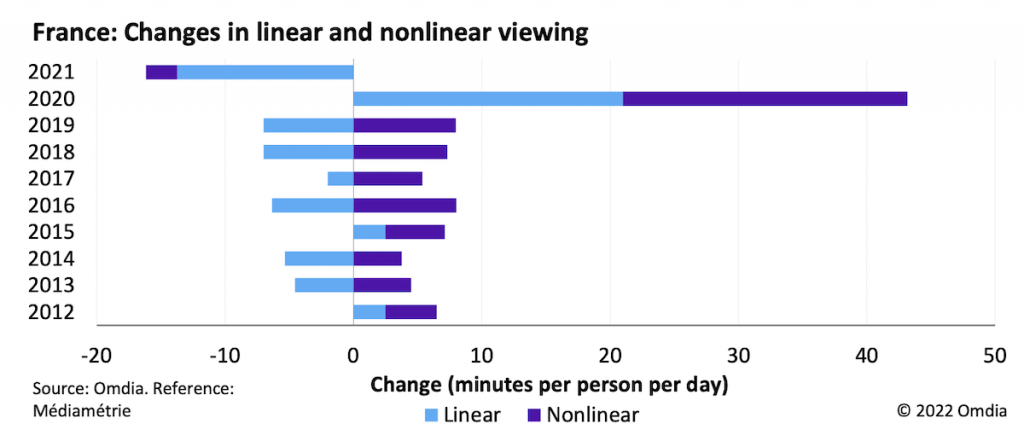
After more than 35 years of operation, TBI is closing its doors and our website will no longer be updated daily. Thank you for all of your support.
TBI Tech & Analysis: Exploring viewing habits across Europe
Over recent weeks, TBI has brought you exclusive insights around content consumption in the US and the UK, courtesy of Omdia’s annual Cross-Platform Viewing Time Report. In this final extract, we explore viewing trends in select countries across Europe.
Linear viewing is in decline across much of the world, but the levels of consumption varies considerably from country to country. In previous weeks, we have seen how viewers in the US have embraced non-linear services, much like their UK-based counterparts.
However, viewers across Europe have tended to follow different paths, with many countries embracing linear for longer, thus leaving on demand consumption below the levels seen in the US. This is, however, changing.
In France, the overall TV viewing time fell (-5.5%) to 279 minutes per person, per day in 2021. Prior to 2020, linear viewing had been in steady decline but saw a massive increase in viewership as a result of lockdowns imposed on the country.
In 2021, however, it has reverted back to this trend of decline, with a 13-minute (-6.3%) decrease on the previous year. A principal driver of this decline was the easing of lockdown restrictions and a return to school and work.
During their third lockdown in April 2021, France issued a stay-at-home order, thereby increasing linear viewing. These restrictions, however, began to subside in May and subsequently led linear to fall under the much higher 2020 figures.
Another factor driving these declines in linear viewing is the rise in adults under 50 viewing content via OTT services, YouTube, Twitch, and using social media channels over traditional TV channels.
Average time spent viewing television and video content across all platforms fell by 5 minutes in 2021, down to 272.6 minutes per person per day.
Both a slowdown in growth from online VOD platforms and the decline in linear viewing account for this overall decline.
Sport continues to be the main driver of TV usage in 2021, with both the Olympic Games and the UEFA Euro 2020 held in 2021 after a one-year delay. News linked to the coronavirus and the parliamentary elections likewise were also key drivers in live TV usage.
Notwithstanding this, linear TV saw a downturn in viewing in 2021, with a 2.9% decline (5.8 minutes) on the previous year.
The popularity of live TV sports has been seized upon in the streaming world now, with both Amazon Prime (UEFA CL) and DAZN (UEFA CL, Bundesliga) acquiring the rights to the country’s top sporting competitions in 2021.
Total television viewing time in Italy fell by 7.6% to reach 293.9 minutes per person per day in 2021, its first decline since 2017.
Linear TV, which recorded the largest increase in viewing in 2020 (28 minutes), followed this with a massive decrease in viewing in 2021, declining by 8.6% – the equivalent of 23 minutes. This, however, still puts it above its 2019 total – an indication that the lockdown measures that carried on until April 2021 continued to play a considerable role in keeping linear viewing higher than its expected trend.
Several factors account for this decline in linear viewing, with the ending of COVID-19 restrictions from April 2021 onwards and the continual shift toward OTT playing a significant role.
Linear viewers, however, have also been lost as a result of Sky losing the soccer rights to Seria A to DAZN. Seria A’s move from Sky (which is measured on linear) to DAZN will undoubtedly see linear decline further in the forthcoming years, particularly as soccer pulls the largest linear audience numbers in Italy.
The extract above is from Cross-Platform Television Viewing Time Report – 2022, written by Omdia analysts Rob Moyser, Ajay Paul and Adam Thomas. To find out more, click here.





